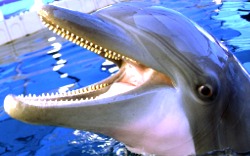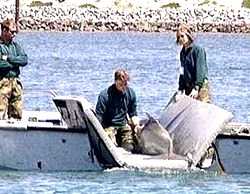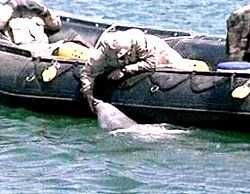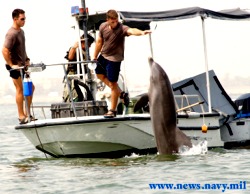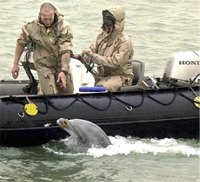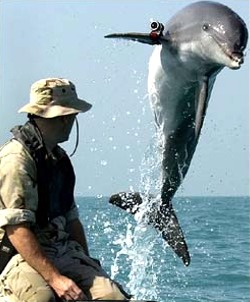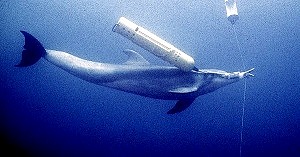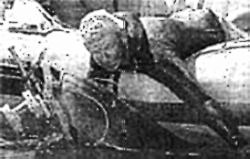   defense dolphins |
Anti-swimmer Dolphins Ready to Defend Gulf Story Number: NNS030812-06 Release Date: 8/12/2003 12:25:00 PM By Lt. j.g. Josh Frey, U.S. Naval Central Forces Central Command/Commander, 5th Fleet Public Affairs MANAMA, Bahrain (NNS) -- With terrorist attacks like that against USS Cole (DDG 67) in October 2000 still a very real possibility, the U.S. Navy has a new ally in the global war on terrorism – the Mk 6 anti-swimmer dolphin system. Much more than your typical Sea World entertainers, these dolphins are dedicated Navy Sailors, standing watch over Arabian Gulf ports and deterring uninvited guests seeking to harm ships and ports. With swimmer defense experience dating back to Vietnam, the Navy’s Mk 6 dolphins are ready to deploy any time, anywhere. “It is reassuring to know that we can put our anti-swimmer dolphins where we need them rapidly and successfully, in order to protect our Sailors, ships and high value assets,” said Lt. Cmdr. Martin Anderson, U.S. Naval Forces Central Command’s Special Operations branch officer. “These dolphins and their handlers provide a valuable capability, by guarding U.S. and coalition ships and piers in the waters of not only the Arabian Gulf, but throughout 5th Fleet waters.”
“They’re able to adapt rapidly, and their biological sonar is very effective,” said Naval Space and Warfare (SPAWAR) representative, Mark Yates, referring to the mammals’ special natural adaptations, such as an efficient hydrodynamic shape, and a very effective natural sonar system that can transmit and receive sound waves. “The adaptations make the animals valuable partners in detecting threat swimmers,” added Sonar Technician (Submarines) 1st Class Dan Cook of Explosive Ordnance Disposal Mobile Unit 3. “Hardware-based systems have limitations that the dolphins make up for naturally, which helps them discriminate between objects and swimmers. This is particularly helpful in high noise environments, such as harbors and bays.”
“We used the data from the sea lions, as well as data from previous marine mammal deployments to the Texas Gulf Coast, to develop climate controlled facilities for the mammals and enhance warm water operations,” explained SPAWAR veterinarian Cynthia Smith. “They have quickly acclimated to operate effectively.” With capabilities that humans and hardware lack, the swimmer defense dolphins provide a formidable defense for U.S. Navy ships and facilities. Their ability to operate in diverse environments make them easily deployable to other areas in the Arabian Gulf, providing stability in the region, and a strong deterrent against terrorist attacks. For related news, visit the Commander, U.S. Naval Forces Central Command/ Commander, 5th Fleet Navy NewsStand page at www.news.navy.mil/local/cusnc.
for first mission A team of specially trained dolphins are getting ready for their first important war missions in the port of Umm Qasr in Iraq. The bottle-nosed Atlantic dolphins - Makai and Tacoma - have been taught by the US Navy to help divers hunt down Iraqi mines in the waters. The navy is training more than 70 dolphins and 20 sea lions to do the job. Their mission is very important because the mines planted by Iraqi troops must be moved to allow ships carrying vital aid through to Iraq. The mammals find mines using their natural sonar. But the clever dolphins are trained to stay away from them when they see one. Once they spot a mine, they are taught to drop a floating marker which tells divers where the explosives are. This means they stay out of danger too. According to the US navy, they are keen and work very hard. But animals rights campaigners are angry the animals are being used like this. They feel they are being exploited, are just being taught tricks and could get hurt. Although the US navy say the only real danger they face comes from other dolphins who might not like new faces in their waters. to Secure Iraqi Ports By Kathryn Schmidt, Washington File Special Correspondent Washington -- The U.S. Navy Marine Mammal Program is making a splash in the Persian Gulf with a unit of dolphins and their handlers who have taken to the waters off the coast of Iraq. Their mission: to clear ports of killer mines. The deployment to Iraq marks the first time the mine-hunting dolphins have been used in a real-world wartime situation. Since arriving March 24 at the port of Umm Qasr and several other locations in Iraq, the dolphin teams have unofficially cleared 913 nautical miles of water, investigating 237 mine-like objects, recovering 90 mines and destroying 11 more. "What is significant here is the large areas which the dolphins can search quickly and report that there are no mines, allowing the search to proceed without the labor-intensive effort of searching every square foot of harbor bottom, literally by hand, to determine if mines are out there," says Tom LaPuzza, Navy public affairs officer for the Marine Mammal Program at the Space & Naval Warfare Systems Center in San Diego, California. Efficiently detecting mines is even more important when there are thousands of desperately hungry Iraqi citizens waiting for humanitarian aid, notes LaPuzza. "Without the marine mammal teams, clearing a lane for a ship, even a narrow [lane], would have taken many long, careful hours of searching if only [human] divers were doing the work." LaPuzza tells of one instance when the Royal Navy ship Sir Galahad, filled with tons of food for Iraqi citizens, was floating outside the Iraqi harbor of Um Qasr waiting to make delivery. The marine mammal teams worked swiftly to clear the harbor channel so the Sir Galahad could enter and off-load its humanitarian aid. Using their biological sonar, dolphins went to work, alerting their human counterparts to anything that looked like a mine while allowing them to bypass areas where there were no mine-like objects. "In that fashion," LaPuzza says, "...it took only a matter of hours to clear a path for the Sir Galahad to get to the pier and unload its food supplies." There is no doubt that clear ports are vital to the flow of aid to the Iraqi people, and the Navy's marine mammal teams have made this possible in record time. "Our troops were going in to free a repressed people from a terrible dictator," LaPuzza says. "Humanitarian assistance in the form of a ship full of food [has become] a symbol of the real point of the war, which was about people and not about who had the most missiles and tanks." Unrivaled by any man-made device, the precise biological sonar of the mine-hunting Atlantic bottlenose dolphins allows them to locate mines and clear areas with unparalleled speed and efficiency. "At more than 100 yards distance, in dark, murky water, a dolphin can easily distinguish between a rock, a small fish, a shark and a discarded boat motor," notes LaPuzza. In the shallow water of a harbor like Umm Qasr, there are all kinds of noises from boats, waves, pier pilings, and other marine life. Dolphins have the ability to overcome such obstacles of sound reverberation to locate mines. Dolphins are not the only marine mammals deployed to the Gulf. California sea lions have been participating in training exercises off Bahrain since January, learning to detect and tag enemy divers. During these "force protection capabilities" exercises, the sea lion alerts a human member of the team when it has spotted a swimmer or diver near a pier or a U.S. Navy ship anchored in the harbor. Then the sea lion attaches a restraining device to the suspicious person and swims away at speeds of up to 25 miles (40 kilometers) per hour. Human counterparts can then drag the suspect to the surface. The Navy uses sea lions extensively to recover practice mines used in training exercises by Navy divers and dolphins. It is estimated that these exercises save the Navy and taxpayers more than a million dollars annually. The U.S. Navy Marine Mammal Program began in 1959 to research hydrodynamics of the dolphin in order to improve torpedo, ship, and submarine designs. Impressed by the dolphins' ability to learn (their level of intelligence is thought to rank between smart dogs and chimpanzees), the Navy began training dolphins, and later, sea lions to perform underwater tasks. In 1996, dolphin teams were called up to support waterside security at the Republican National Convention in San Diego. Earlier, dolphins were used in Vietnam in 1970 and 1971 to help protect an Army ammunition pier in Cam Ranh Bay from further attacks by North Vietnamese divers. In 1987 to 1988 dolphin teams were deployed to Manama Harbor in Bahrain to protect the Navy's Sixth Fleet flagship, the USS LaSalle, which was helping direct Kuwaiti tankers through the Strait of Hormuz, a channel that had been mined by Iraq during the 1980-1988 Iran-Iraq war. Today, LaPuzza says, the program has a budget of $10 million to $20 million annually, with 75 dolphins and 20 sea lions onboard. He says it takes at least three years to train dolphins in complex behaviors such as detecting mines. While the Navy does not discuss future operational deployments, LaPuzza says, "as a long-term strategy, it is the plan of the Navy to develop hardware systems that are ... effective enough to replace dolphin systems.". For the foreseeable future, however, there is no comparable replacement for these mine-hunting teams that have played an integral role in assisting coalition forces, and delivering aid to needy Iraqi people. On the frontline in Iraq At least 75 dolphins and 20 sea lions have been trained and employed by the US Government for warfare. Having endured long flights in water-filled sleeves, they were on the frontline in the recent Iraqi conflict, unknowingly risking their lives for the troops. Dolphins, referred to by the military as 'Advanced Biological Weapons Systems', have been used by the US military to search for mines since Vietnam. Their most recent task was to keep shipping lanes free in the Gulf. Food deprivation The dolphins are controlled through food deprivation. When dolphins are full, they are very difficult to 'control', as there is no incentive for them to return. So, when searching for mines, they are fitted with what are known as 'Anti-Foraging Devices' (AFD) - a piece of Velcro wrapped around their snout preventing them from opening their mouths and catching fish. This encourages them to return to base. If a dolphin does go AWOL, a 'recall pinger' is set off at a frequency that can be heard by the animals over long distances. If they return on hearing this, they are rewarded by having the AFD removed and being fed. Using dolphins as military tools also endangers the indigenous dolphins in the area. Troops do not know which dolphins the enemy is using and which it is not. This means that they kill all that they find just in case. Sea lions have been used in recovery missions for the past 30 years. But the Gulf conflict saw their first frontline mission. Their task was to patrol for enemy frogmen. The military's use of these animals is protected under national security exclusions. This means that the military can use the animals pretty much as they please and the truth about how they are really treated is difficult to discover.
(Post-Gazette, March 27, 2003) Hannibal's elephants crossed the Alps to battle the Romans 2,200 years ago. Combat dogs have fought wars for centuries. Pigeons performed messenger duty in World War II. There never would have been a cavalry without horses. Even glow worms have served in the military. All sorts of animals have been enlisted -- or drafted -- for wartime duty. Many have served far more dangerous duty than the dolphins pressed into service against Saddam Hussein. Hannibal's elephants died in droves as the general from Carthage forced them over the Alps. The Romans killed more in the ensuing battles. At least 8 million horses, mules and donkeys died in World War I, according to a British estimate. Use of pack mules continued in WWII, with 10,000 used in Greece alone. Some 100,000 pigeons in World War I and 200,000 in World War II flew messenger missions, and they suffered huge losses. Coalition forces in Iraq are using pigeons, too -- as chemical warfare detectors. They will serve by dying, to alert troops of a chemical attack. War dogs have been a battlefield fixture throughout history. Scout dogs sniffed out enemy positions; message dogs carried communiques; medic dogs rescued wounded soldiers. Germany used 30,000 messenger and ambulance dogs in WWI. When the French demobilized, they killed 15,000 dogs, according to a 1952 U.S. Army history of war dogs. The U.S. Army trained 10,000 dogs for WWII, and canines served with great valor in Korea, Vietnam and the first Gulf War. As for the glow worms -- soldiers in WWI sometimes smashed them on their helmets to serve as a nighttime signal to friendly forces. Needless to say, the casualty rate was significant. |
(By David Lindorff, CounterPunch, April 3, 2003) News that Takoma, the Navy's mine-detecting dolphin, has gone AWOL while on duty in the Persian Gulf, sets off a host of thoughts. First of all, do we know that Takoma is really AWOL, or is this just another example of the Pentagon's trying to hide war casualties from the American public by classifying slain troops as missing or AWOL. It would not just be tragic if one of the U.S. military's sea mammal soldiers was killed in action; it would surely raise a storm of protest from a group far more powerful than the peace movement: the animal rights crowd. Both Americans and Brits have always been much more troubled by cruelty to animals than to humans, and it's a certainty that this is a group Allied Forces has no desire to arouse. The peace movement can be safely ignored by Washington, at least for a time, but a fired-up animal rights movement could bring down the government in no time. But while the Pentagon may well be fudging its human casualty figures, there is reason to suspect that Takoma is safe. Dolphins, after all, are known to have brains that are larger than we humans are possessed of. And while they are known to be capable of extreme brutality, even towards others of their own species, on an individual basis, there is no indication that dolphins engage in humanity's uniquely barbaric practice of war. It's possible then, that once he or she realized that her efforts were not a game anymore but were part of a campaign designed to enable one group of humans to kill large numbers of other humans, Takoma decided to split the oil-befouled waters of the Persian Gulf for the more tranquil and dolphin-friendly Indian Ocean. One imagines that the Pentagon is now contemplating having to train a group of dolphin MPs (or perhaps they're working on sharks for this job), to keep the remaining dolphin mine-sweeping squad in line. If the military turns to coercion though, it will inevitably produce a counter-reaction in the dolphin community: militant dolphin pacifism--a movement that could see peace-minded dolphins luring Pentagon-trained dolphins away from their assignments and back to the freedom of the open sea. |
|
(CNN, March 26, 2003) DOHA, Qatar (CNN) -- A coalition team of Australian and British navy divers aided by specially-trained dolphins have completed work to clear mines from sea lanes around the Iraqi port of Umm Qasr, opening the way for humanitarian aid shipments, military officials say. The first shipment of much-needed food and medical aid is expected to dock in the port as early as Thursday. The two dolphins aiding the mine-clearing effort came from a U.S. Navy facility in San Diego, California and were flown into Umm Qasr by helicopter earlier this week. Their handlers say they have been trained using their natural sonar abilities to locate and mark submerged mines. The dolphins, Atlantic bottle-noses named Makai and Tacoma, carry fin-mounted sensors which record their response to underwater targets enabling their handlers to pinpoint the location of suspected mines. Officials say the dolphins are taught to keep a safe distance from the mines and face little risk in carrying out their duties. Umm Qasr is Iraq's only deepwater seaport and, until it was closed by the threat of war, was the main entry point for food and other aid under the United Nation's "Oil For Food" program. An estimated two-thirds of Iraqis relied on the food delivered under the U.N. deal for their daily needs. Amid warnings of a looming humanitarian crisis, coalition forces are under pressure to deliver on promises from U.S. President George W. Bush to provide "massive amounts" of aid to the Iraqi people. (Aid shipments) On Wednesday seven aid trucks arrived in Umm Qasr bringing with them about 12 tons of food, medical supplies and other goods. The trucks, which had been held up at the Kuwaiti border, were finally allowed to cross into Iraq Wednesday after coalition forces confirmed they had secured the city. They are expected to be followed as early as Thursday by the arrival of Britain's H.M.S. Sir Galahad, carrying tons of items such as food, blankets, clean water, medicine and plastic sheeting. The shipment will be the first crucial step toward transforming what has become a battlefield back into a working port. However, aid agencies say that with war likely to drag on for several weeks if not months, coalition forces will have to work extremely quickly to open aid routes or face a humanitarian crisis affecting hundreds of thousands of people. © 2003 Cable News Network LP, LLLP.
(CNN, March 26, 2003) (CNN, March 26, 2003) The Surveillance Towed Array Sensor System (SURTASS) Low Frequency Active (LFA) is a new sonar the U.S. Navy needs for national security. for Humanitarian Ships (By Suzanne Freeman) Wednesday, March 26—Two Atlantic bottle-nosed dolphins were deployed by the Navy to the Persian Gulf today. The two specially trained dolphins are searching the waters for explosives around the port city of Umm Qasr. Makai, 33, and Tacoma, 22, both males, use their natural sonar abilities to locate mines and mark them with floats. The dolphins are working in the Khor Abdullah waterway to clear a path for the first ship carrying humanitarian aid, Britain's Sir Galahad. The Navy has 20 trained dolphins as part of the Marine Mammal Project based in San Diego, California. Nine of those dolphins were flown to the Persian Gulf recently. They are staying in specially built tanks aboard a U.S. warship. Makai and Tacoma were flown by helicopter in special travel sleeves to the port at Umm Qasr. Both were doused with water on the trip. The Navy dolphins are taught to avoid touching the mines, which could cause them to explode. According to one bomb-disposal expert, the dolphins are more at risk from local dolphins than the mines. Dolphins are territorial and could drive away the two newcomers. "They are like children really," Tacoma's handler, Petty Officer Taylor Whitaker, told reporters. "They are keen and work very hard and very effectively, but sometimes they can have a bad day and they do not do so well. Tacoma is one of the most vocal ones we have and one of the best at his job." Whitaker is only 1 year older than Tacoma. Dolphins have a long history with the Navy. They were used to protect warships from enemy divers during the Vietnam war in the 1960s. They were also used to plant mines on enemy vessels during the Cold War. A wartime first: Dolphins called to clear mines Navy program is put to work in Persian Gulf (By Tim Friend, USA Today, March 27, 2003) The U.S. Navy has deployed an undisclosed number of "marine mammal systems" to hunt down mines in the Persian Gulf at the southern Iraqi port of Umm Qasr. The "systems," known in non-military circles as bottlenose Atlantic dolphins, are trained to recognize mines using their sensitive echolocating sonar and to mark the locations of mines with special buoys. The dolphins are part of Navy Special Clearance Team One, which specializes in mine countermeasures for Navy and coalition vessels. Maj. Gen. Victor Renuart of Central Command told reporters Tuesday that dolphins already have started searching for mines at Umm Qasr. Mine clearance is necessary to ensure the safety of U.S. and coalition ships as well as ships carrying humanitarian aid to the Iraqi people. Tuesday's deployment marks the first time dolphins have been called to war to clear mines, said Tom Lapuzza, spokesman at the Space and Naval Warfare Systems Center in San Diego. "We do this all the time for training in different parts of the world, but we have never taken mine-hunting dolphins to a war zone," Lapuzza said. At least two dolphins, Makai and Takoma, are taking part in the Persian Gulf mission. Lapuzza would not reveal the number of animals involved. Capt. Mike Tillotson, a bomb-disposal expert for the Navy, said the dolphins are trained to avoid touching mines. Animal rights groups have criticized the Navy's use of dolphins since its Marine Mammal Program began in 1960 with a single female Pacific white-sided dolphin. But the National Marine Fisheries Service, which oversees the Navy's marine mammal wards, has reported that Navy's dolphin survival rates are 95% to 97% for the past decade, the highest of any group holding captive dolphins, including academic centers and Sea World. Survival rates in the wild are 92% to 95%. The Navy employs about 75 dolphins, which are "paid" for their duties in fish. One of the animals has been involved in the Marine Mammal Program for about 30 years. Lapuzza says only positive reinforcement is used during training. The animals live in roped-off areas of the bay at San Diego and in similar open areas at other training sites. They are trained without tethers in the open ocean almost daily. In 30 years of training, only seven dolphins have gone AWOL, and that was because animals and trainers became separated during bad weather. As the dolphin gets closer to an object, the clicks are made at shorter intervals. When a dolphin is investigating an object at close range, the clicks sound like a buzz. Dolphins are able to form mental pictures based on the echolocation patterns made by an object. The Navy is developing unmanned robots to do the same job, but they are still no match for the sensitivity of dolphin sonar. The only animal on Earth known to have a higher range of hearing is the bat.
Two Atlantic bottlenose-dolphins — likely trained in Hawai`i — were deployed to the Middle East to help coalition forces. The dolphins, named Makai and Tacoma, were sent to the port city of Umm Qasr where they will help locate underwater mines. While there were reports over the weekend that Takoma had gone AWOL, Navy officials reported late Sunday that he'd returned about 48 hours later. In addition to dolphins, the Navy is also using California sea lions trained to recover unarmed practice mines and to locate underwater swimmers, and then attach a restraint device. They will participate in a demonstration of their abilities in Bahrain in the upcoming weeks, according to a Navy release. The dolphins use their highly developed sonar to locate and then mark the underwater mines so that human divers can deactivate them. This work has angered some animal rights groups, however. The animal rights group PETA recently released a statement opposing the military's use of dolphins and other animals in the war against Iraq. Wars are human endeavors, PETA argues, and animals should be left out of it. The dolphins are part of the Navy Special Clearance Team ONE, according to a recent Navy press release, which will conduct mine countermeasures, or MCM. The team consists of a dive platoon, a dolphin platoon and an unmanned, underwater vehicle platoon. "A whole bunch of our dolphins have Hawaiian names," said Tom Lapuzza, public affairs officer for the Navy Marine Mammal Program in San Diego, in an interview with the Honolulu Advertiser. "A number of them were collected in the Gulf of Mexico and almost all were flown to Hawai`i, where the basic training and systems were developed." Capt. Mike Tillotson, a Navy bomb disposal expert, told the Advertiser that dolphins are taught to avoid touching the mines, and that there is little risk to animals doing this kind of work. The biggest hazard could come from other indigenous dolphins in the waters of Umm Qasr — dolphins are territorial and there is a fear local dolphins might drive the newcomers out. According to the Navy, the future of mine detection will depend more and more on unmanned systems. When the technology is fully mature, such systems will be used to reduce the risk to both man and dolphin in MCM operations and will allow divers to focus on high priority targets. According to the Navy, the military began using marine mammals in the early 1960s. Military researchers were investigating how their highly developed senses like the dolphins sonar could be used to locate mines and do other tasks. 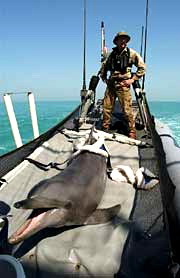 Undersea Agents in Iraq (John Pickrell for National Geographic News, March 28, 2003) The hundreds of thousands of American, British and other forces stationed in the Persian Gulf region are currently employing some rather unusual allies in the battle to depose the Iraqi leadership. A crack troop of United States Navy-trained dolphins were at work this week, helping to locate potentially lethal and obstructive anti-ship mines, littering the seafloor near the port of Umm Qasr and other locations. The Navy's Special Clearance Team One from San Diego, California, comprises platoons of human divers, unmanned underwater vehicles and intensively trained bottlenose dolphins. Dolphins' unrivalled underwater sonar abilities, and great intelligence, make them uniquely suitable for locating mines in cluttered shallow-water environments where military electronic hardware is rendered virtually useless. "Dolphins have the best sonar on this planet… the Navy does not have any technological sonar that can find buried mines except for their dolphin system," said Whitlow Au, who studies marine bioacoustics at the University of Hawaii's Marine Mammal Research Program in Kailua. "They can not only find objects like mines that may or may not be buried into the seabed, but they can distinguish them from clutter such as coral rock, and man-made debris," he said.
sold to Iran By Lewis Dolinsky, San Francisco Chronicle, Mar 15, 2000 The Soviet Union trained dolphins to locate torpedoes and missiles (great sonar) and to carry explosives for blowing up enemy ships, even to attack divers with harpoons attached to their backs. The dolphins and beluga whales, seals and sea lions were in an oceanarium in Sevastopol in the Crimea until the whole lot was sold to Iran because trainer Boris Zhurid had no money to take care of them. He went, too. ``If I were a sadist,'' he told the Moscow newspaper Komsomolskaya Pravda, ``I would stay in Sevastopol. But I could not stand to see my animals starve. . . . I am prepared to go to Allah, or even the devil, as long as my animals will be OK.'' According to the British press, the dolphins, etc., are housed in a new oceanarium in Iran. Zhurid had been teaching them circus tricks. It is not clear what their new duties will be, but the U.S. Navy used dolphins in the Persian Gulf in 1987-88 to protect ships from mines. The marine mammals were trained to kill. By J.A. Getzlaff, Salon, Mar 24, 2000 March 24, 2000 - I t sounds like the plot from a stupid B-movie, but it's true: A marine mammal trainer and former Soviet militiaman just sold four "killer" dolphins and a white beluga whale to Iran. According to a BBC report, the dolphins and whale were trained by the Soviet navy to attack "enemy frogmen with harpoons attached to their backs" and carry out "kamikaze strikes" against enemy ships. The animals learned to distinguish between Soviet and foreign submarines by the sounds of their propellers and were taught to carry mines to the hulls of enemy vessels to blow them (and themselves) up. When funding for the project was cut off, the highly trained creatures wound up in a tourist "dolphinarium" in Sevastopol, located on the Crimean Peninsula on the Black Sea. Their military trainer, Boris Zhurid, continued to train them at the dolphinarium, but decided to sell the mammals when the aquatic sideshow began to lose money. He told the Russian newspaper Komsomolskaya Pravda that there was no longer enough food and medicine for the animals at the dolphinarium. "If I were a sadist," he said, "then I could have remained in Sevastopol." In addition to the dolphins and whale, Zhurid sold sea lions, seals, walruses and three cormorants to Iran -- 27 animals altogether. The creatures were flown by Russian transport aircraft from Sevastopol to the Persian Gulf, where their fates remain unknown. By Linda Rothstein, Bulletin of The Atomic Scientist (November/December 1997)
These Russian-trained dolphins, like their American-trained counterparts (dolphins and sea lions), formed a secret force that searched for mines and guarded sensitive military facilities from underwater sabotage. In darker days, few details were known about either the U.S. or the Russian Navy's use of dolphins. But a great deal of information about the American dolphin corps was declassified in 1995, and in the August 4 New York Times, reporter Michael Specter described his visit with some of the former Soviet dolphins, who are stationed in Sevastopol in the Ukraine. After the Soviet Union dissolved in 1991, says Specter, Russia's special forces dolphins were inherited by the Ukrainian Navy. That navy, and the economy of Sevastopol, which was dependent on the navy, were left bankrupt. Many of the ex-Soviet dolphins faced starvation without new employment. Capt. Nikolai Savchenko, a spokesman for the Ukrainian Navy, said, "We thought about everything. We tried to persuade oil companies to retrain them. But nobody was interested." Then, in a brilliant stroke of defense conversion, someone came up with the idea of enlisting the dolphins as child therapists. That was their salvation. According to Dr. Lyudmila Lukina, a physician who runs a therapy program in which disturbed and extremely shy children are brought into contact with the dolphins, the highly empathic creatures have demonstrated as much talent in their civilian as in their military careers. A couple of questions about the Soviet marine mammal program remain, however. Only 20 of the 70 dolphins appear to be employed in the child therapy program, and no one is saying what happened to the others. If they survived the bad times, they may still be involved in military activities. Dr. Lukina refused to answer any questions about that possibility. Many thought the U.S. Navy's dolphins and sea lions-known mainly through rumor at the time-would also be pensioned off after the Cold War. But it was not to be. The navy's "Marine Mammal System" appears to be more robust than ever. In 1993, dolphin duties were expanded from near-shore patrol to operations from ships at sea. A report in the August 1997 issue of Proceedings, a publication of the U.S. Naval Institute, offers some powerful reasons why "American" dolphins are still wearing navy blues: When it comes to clearing underwater mines, they're simply better than anyone else-10 to 12 times more effective than their human counterparts at "demonstrated first-pass mine-clearance capabilities." And unlike humans, they have few underwater vision problems, and they work as well at night as in the daytime. Then there are dolphins who guard installations against attack: The "Mk6" [a dolphin unit] "participates regularly in fleet exercises and real-world base security, providing the nation with its sole comprehensive surface and subsurface swimmer detection and response capability." The U.S. Navy's sea lions are no slouches, either. In tests over a 20-year period, sea lions stationed in Charleston and San Diego have maintained an amazing 95 percent success rate in locating the dummy mines and torpedoes they were asked to find. U.S. Navy dolphins first earned their reputation at Cam Ranh Bay, where in 1970-71 their patrols brought an end to underwater sabotage. They were also deployed in Bahrain in 198788, during a period in which Iran was laying mines in the Persian Gulf in an effort to disrupt oil shipments. Today, the navy's active duty roster includes 40 dolphins and sea lions, with another 50 in training in San Diego. The navy also believes that veterans of its marine mammal programs (who may live into their 50s) should be well cared for. The navy now runs a retirement home in San Diego for 10 of its dolphin vets. How likely is it that the navy's dolphins will all don civvies? It is possible. The navy is now exploring a variety of "autonomous search and neutralization systems"-robots-to replace human divers. So far, however, the humans are doing better than robots, and the dolphins still do better than the humans. |
